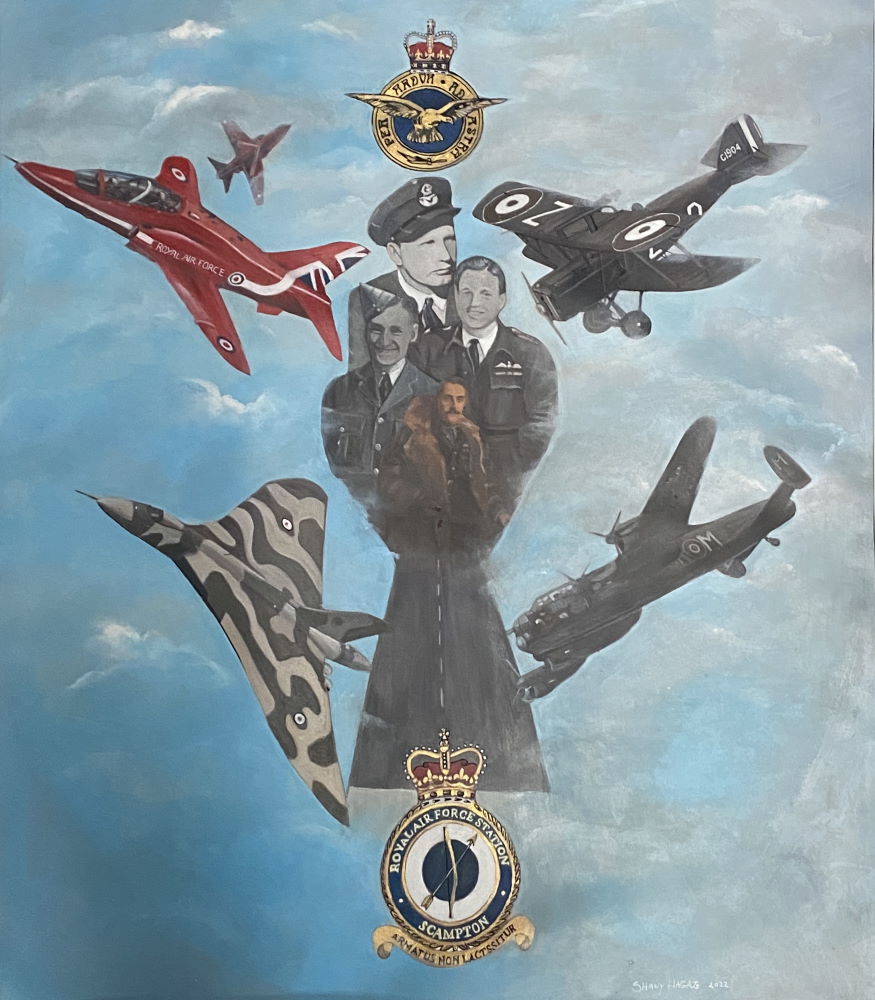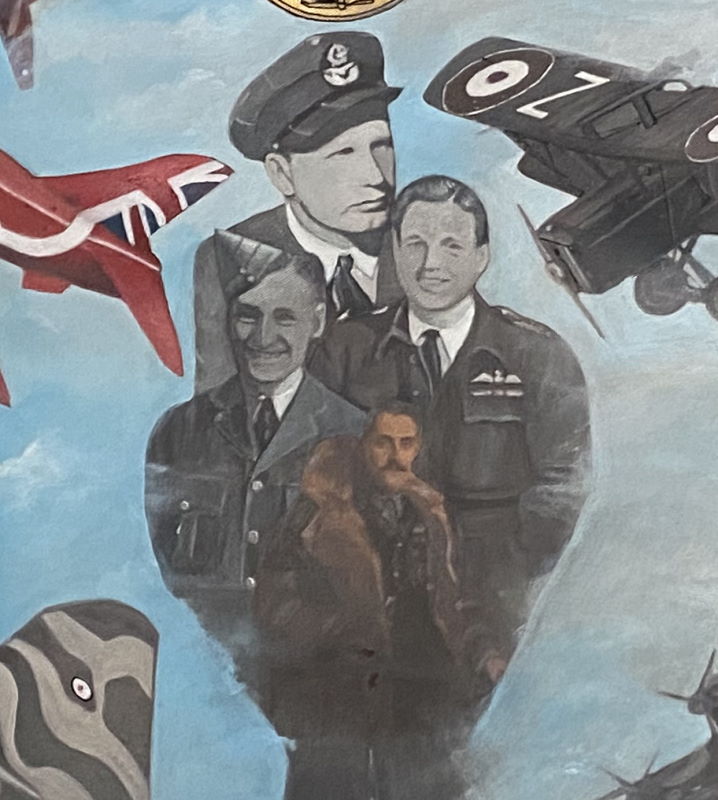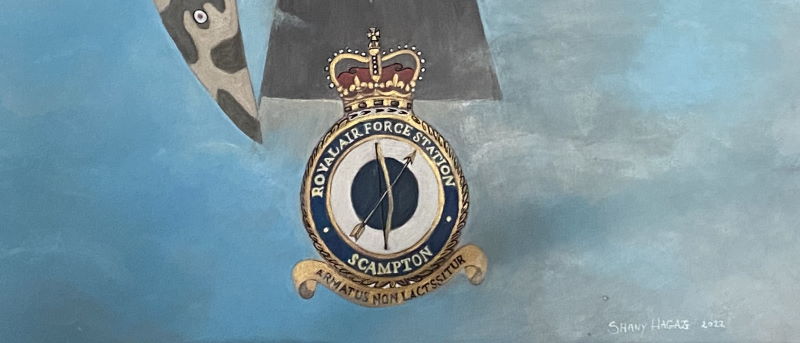This painting was created by commissioned artist Shany Hagan to commemorate the rich heritage of RAF Scampton on the event of the Station’s closure. The proceeds are being donated to RAF Scampton’s three station charities, not just one. Information on how to bid is included at the end of the article.
RAF Scampton has a widespread and significant history, from being the base of 617 Squadron (also known as the Dambusters), to housing the United Kingdom’s nuclear deterrent in the cold war era – the Blue Steel Nuclear Missile.
The Station was within 5 Group and 1 Group Bomber Command during WW2. It was involved with operations from the very first day until the last days of war in May 1945, when its squadrons took part in Operation Manna, a humanitarian operation which saved the lives of thousands of Dutch people dying from starvation. Scampton’s losses were 266 aircraft and 561 men during WW2.
It is also the only RAF station to have been honoured by the highest British gallantry award of the Victoria Cross on three separate occasions, and further awards for gallantry of a George Cross and a George Medal.
RAF Scampton has the honour of having the first Bomber Command VC (Roderick Learoyd) ofWW2, the youngest aviator and military VC of WW2 (John Hannah) and the most famed RAF pilot
VC of WW2 (Guy Gibson). No other RAF station can match those achievements in RAF history.
The painting measures with carded frame 94cm h by 84cm and visible picture 79cm h by 70cm w.

The station was also famously known for being home to the Red Arrows, one of the world’s premier aerobatic display teams. Famed for their trademark Diamond Nine Shape, this Red Arrows have been flying in displays since 1965 and have flown in almost 5000 displays in 57 countries. The team are the public face of the RAF, and ambassadors for the United Kingdom across the world. The painting depicts four iconic aircraft of the 20 the century: the Royal Aircraft SE5, Lancaster, Vulcan and Red Arrow Hawk. Seen below these are four of RAF Scampton’s most notable aviators, three being Victoria Cross recipients:
Wing Commander Guy Gibson VC, DSO & Bar, DFC & Bar
Undoubtably the most famous and well-known RAF Scampton Victoria Cross recipient was Wing Commander Guy Gibson. Gibson was initially posted to RAF Scampton in February 1943 to form and command 617 Squadron. It wasn’t his first association with the station, as this was earlier in March 1938 when the squadron he was on as young Pilot Officer (No 83) was transferred to RAF Scampton. He flew Hampdens with 83 Squadron from the first day of WW2 completing 34 operations during his first tour.
His next posting was to 29 Night Fighter Squadron during which he flew 99 missions at RAF Digby followed by promotion to Wing Commander and command of 106 Bomber Squadron at RAF
Syerston completing 32 operations. By this time Gibson had been awarded two DFCs and two DSOs and was highly thought of by Arthur Harris being one of the most experienced bomber pilots and hence asked if he would volunteer to command a new special squadron to carry out just one special operation, the raid on the Ruhr Dams (Operation Chastise) from RAF Scampton.
On the night of 16–17 May 1943, Wing Commander Gibson led No. 617 Squadron on Operation Chastise, later becoming known as the Dambusters. The task was fraught with danger and
difficulty. Gibson personally made the initial attack on the Möhne Dam. Descending to within a few feet of the water and taking the full brunt of the anti-aircraft defences, he delivered his attack
with great accuracy.

Afterwards he circled very low for 30 minutes, drawing the enemy fire on himself in order to leave as free a run as possible to the following aircraft which were attacking the dam in turn. Gibson
then led the remainder of his force to the Eder Dam where, with complete disregard for his own safety, he repeated his tactics and once more drew on himself the enemy fire so that the attack
could be successfully developed. Guy Gibson did not survive the war and was killed in action returning in a Mosquito from an attack on Moenchen-Gladbach in September 1944 during which he was master bomber
Wing Commander Roderick Learoyd VC
On 12 August 1940, No. 49 and 83 Squadron’s Hampdens were part of a raid against the Dortmund-Ems Canal. Two aircraft had been lost due to anti-aircraft fire prior to Wing Commander Roderick ‘Babe’ Learoyd making his attack, which would involve an attack at low level. During his attack, Learoyd’s aircraft was caught in the searchlights, taking two hits in one wing. Despite this, Learoyd was still able to provide his bomb aimer with a steady platform in order to deliver his bombs.
Learoyd then nursed the Hampden back to England, arriving in the vicinity of Scampton at 02:00. Although the aircraft was flyable, its hydraulic systems had been damaged and the wing flaps were inoperable. The undercarriage indicators had also failed and rather than risk a landing in the dark, Learoyd circled for three hours before making a landing at first light. He was awarded the Victoria Cross for his courage, skill and determination. Learoyd eventually promoted to Wing Commander went on to command the first Lancaster Squadron (No. 44) and survived the war.
Sergeant John Hannah VC
At only 18, Hannah was the youngest airman to receive the Victoria Cross when he was a newly promoted Sergeant with 83 Squadron at RAF Scampton flying Hampdens. On 15 September 1940 his aircraft was involved in a raid on a target near Antwerp during which the Hampden received a hit in the bomb bay, leading to an explosion and serious fire.
On the 15th September 1940, over Antwerp and following a successful attack on German invasion barges, the Hampden in which he was flying as a Wireless Operator/Air Gunner was badly hit by
Incendiary Flak which started a fire which quickly spread through the aircraft. Both Hannah’s position and that of the rear gunner were engulfed in flames, and although the rear gunner had
bailed out, Hannah elected to remain at his post, fighting the fire with extinguishers, and when these expired, his hands.
He successfully prevented the fire from reaching the aircraft’s ruptured fuel tanks despite ammunition exploding and the floor beneath him melting. Although severely burned, Hannah
forced his way forward to the navigator’s station, only to find the navigator had also bailed out. He then managed to locate the navigation logs and charts and assisted the pilot in navigating the crippled Hampden back to RAF Scampton. Hannah later had to be invalided out of the RAF due to his serious injuries and died in 1947 aged only 25 from TB, believed to be caused by his injuries. His Canadian pilot Clare Conner was killed less than two months after the operation over Antwerp and is buried in Brattleby Parish Church
Wing Commander James ‘Jim’ Flint DFC, GM, DFM, AEc
On the night of 5th/6th July 1941, Flint was captain and pilot of an 49 Squadron Hampden which was attacked by two enemy aircraft whilst over the sea about 50 miles from the Norfolk Coast. As
a result of the damage sustained, Flint was compelled to ditch the aircraft on the water 800 yards from the shore. The wireless operator and air gunner were able to escape the aircraft but there
was no sign of the navigator. Flint was unable to open the astro hatch so he lowered the back of the pilot's seat, crawled through the aperture, and found the navigator, who had been badly
wounded, helpless behind a spar where he had fallen. The aircraft was fast sinking, but Flint managed to drag the navigator out through the pilot’s hatch. The dinghy had been punctured and
due to only being partially inflated, sunk at once with the aircraft. The wounded air gunner swam towards the shore. Flint, at first assisted by the wireless operator until his wounds prevented him
from continuing, supported the helpless navigator until they were within 50 yards of the shore where a soldier who had come out to render assistance relieved him. Flint then swam to the shore and saw that both the wireless operator and navigator were safe.
Finding no sign of the air gunner, he asked for boats to be sent out to search for the missing man, at the same time giving clear instructions where to look for him. He refused to leave the beach
until he had seen that boats were searching for the air gunner who, it was subsequently found must have succumbed to his wounds and drowned. Flint then walked for over a mile to a waiting
ambulance and was taken to hospital.
Flint was awarded the George Medal for his efforts in trying to save his Navigator and also a Distingished Flying Medal in out manoeuvring the enemy fighters. Two medals during one
operation was an unknown occurrence until this time. Flint became a Wing Commander and was OC 50 Squadron at RAF Skellingthorpe in 1944/45. He passed away aged 100 in 2013.
Completing the piece is the crest of RAF Scampton and the badge of the Royal Air Force. The crest for RAF Scampton features a Longbow bowstring, which represents Ermine Street, a historic route through the north of Lincolnshire. Its route and surrounding views greatly assisted pilots during World War I, whilst training and returning to the airfield. The arrow represents the runway itself.
Underneath the image is the Latin term “armatus non lacessitur” – which translates to “an armed man is not attacked”

The proceeds are being donated to RAF Scampton’s three station charities, not just one. The three charities are Royal Air Force Association, Wish Upon a Star and Mind.
Notes
The auction will take place on 26th March at Unique Auctions, Lincoln, with all proceeds being donated to RAF Scampton’s main Station charity – Royal Air Force Association.
The lot 2100A is expected to be sold around 10am on the 26th March.
Members of the public are welcome to attend the auction and the auction can also be viewed and bid online at The-Saleroom.com and Easyliveauction.com (please note that if you bid online there will be auction service fees).
The lot will be sold with no commission and no fees from Unique Auction, so all monies will be given direct to RAF Scampton.
Bidding Information
Potential buyers can bid at the auction room in person on Sunday 26t March.
Buyers can also leave commission bids or request a telephone bid.
Buyers can also bid online (please note that if you bid online there will be auction service fees)
Click to view Catalogues and bid through the-saleroom
(online commission 4.95%)
Click to bid through EasyLiveAuction
(flat fee £3 or commission 3%)
